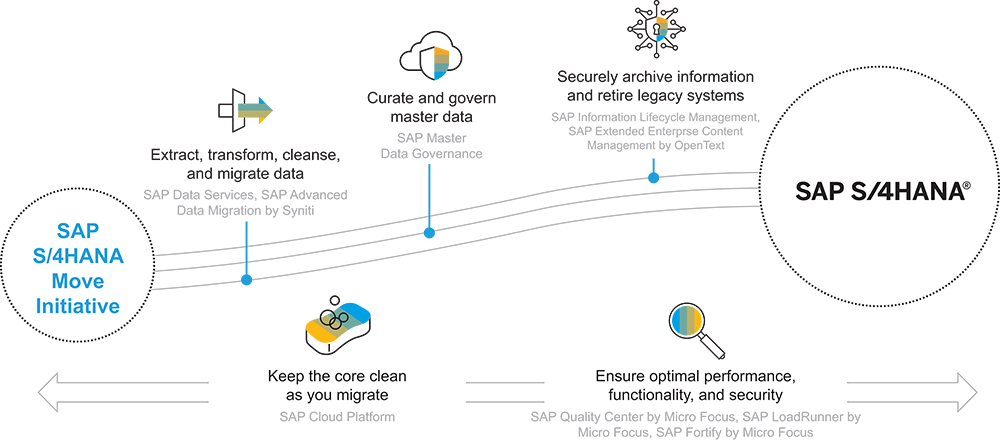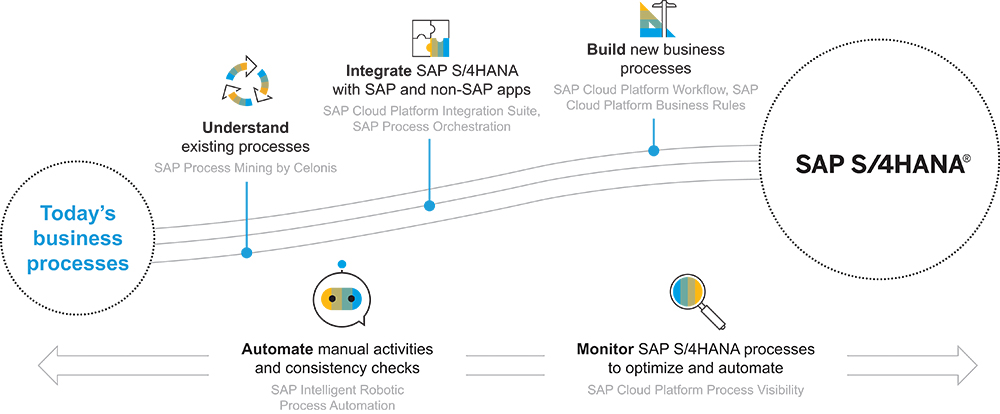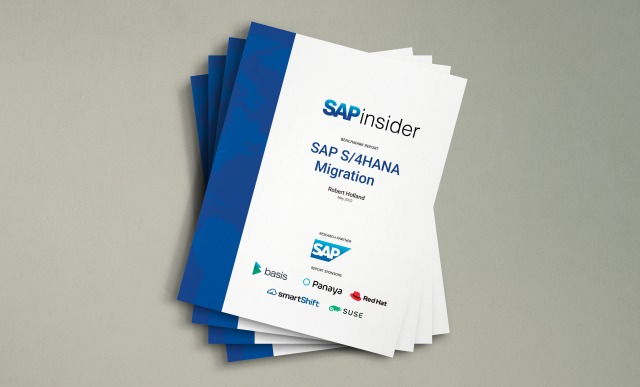Are You Ready for SAP S/4HANA? The Time Is Now
by Heather Black, Senior Editor, SAPinsider
SAP S/4HANA is here. In fact, it has been here since 2015, and a majority of SAP customers are now at some stage of an SAP S/4HANA migration, whether it’s an evaluation or live deployment. According to SAPinsider’s February 2020 “SAP S/4HANA Migration Benchmark Report,” 85.5% of survey respondents are somewhere along the journey — with 17% already live (up from 8% a year ago) and 14.5% with no plans to migrate (down from 34% a year ago). Considering the approaching 2027 end-of-mainstream-maintenance date for systems based on SAP ERP Central Component (SAP ECC), these numbers are not surprising.
While the end-of-mainstream-maintenance deadline is a significant factor when it comes to undertaking this migration — it was cited as a main driver by 43% of survey respondents overall in the “SAP S/4HANA Migration Benchmark Report” — it is not the only driver. According to Carl Dubler, Global Head of SAP S/4HANA Adoption Marketing at SAP, many customers currently running ERP systems are working with technology that could be decades old. “A lot of customers need to modernize, because the software that was written in the early 2000s isn’t really going to handle what they need their business to do in 2020,” he says. “They need to be ready for the challenges that this new decade is going to bring to their business.”
Explore related questions
Today’s business environment requires agility, visibility, and the ability to rapidly make decisions and react to problems and opportunities. In traditional landscapes, businesses look at ERP systems as a back-office system, and build separate satellite systems around the ERP system to handle functions such as analytics and billing.
This approach can create complexity due to the exchange of data as well as latency that can prevent visibility into the transactional system, according to Marcus Venth, Global Vice President, SAP S/4HANA Business and Market Development at SAP. “If they continue to build it out, they’re just going to end up with an even more complex environment that is not going to be able to change as they change,” he says. SAP S/4HANA removes this complexity and enables agility through built-in features for analytics, subscription billing, transportation management, and extended warehouse management functionality, allowing customers to consolidate multiple systems into one. “With these advanced features that we have, we are able to essentially eliminate a lot of these redundant satellite systems,” he adds.
SAP S/4HANA not only delivers the simplified landscapes and advanced features and functionality modern businesses require, it is a mature, proven intelligent ERP solution that is already in use by thousands of customers, such as VINCI Energies, which consolidated a multitude of systems onto a single-instance SAP S/4HANA system that went live in July 2018. With SAP S/4HANA five years old and SAP HANA 10 years old, customers can be confident that they are not stepping into something that is risky and untried, according to Dubler. In addition, SAP provides tools and technologies, such as SAP’s Business Technology Platform portfolio of solutions, that help ease and accelerate the migration journey for organizations.
SAP S/4HANA is a mature, proven
intelligent ERP solution that is already
in use by thousands of customers, such
as VINCI Energies, which consolidated
a multitude of systems onto a single-
instance SAP S/4HANA system that
went live in July 2018.
So, with SAP S/4HANA as the clear path forward, where do SAP customers start?
Not Just a Migration — an Opportunity
Moving to SAP S/4HANA is not just a migration from old software to new software — it is also an opportunity. Customers that have not yet moved to SAP S/4HANA are typically running fairly recent versions of SAP ERP, such as SAP ECC 6.0, according to Venth, that have varying levels of customizations to address different needs. With SAP S/4HANA, in addition to being able to simplify complex landscapes, these customers have an opportunity to take advantage of new features and process improvements that address their business needs in a better way — such as the Universal Journal concept, an SAP HANA-based material requirements planning engine, and embedded analytics. To help customers identify these kinds of opportunities and build the business case for SAP S/4HANA, SAP provides the SAP Business Scenario Recommendations tool, which identifies the functionalities within SAP S/4HANA that will help an organization meet its unique business goals. “The strongest business cases will be those that involve the business and address either business pain points or a strategic business direction that the application would be able to support,” says Venth.
An SAP S/4HANA migration is also an opportunity to think about a cloud deployment, which is the approach leaders — those that are seeing excellent or exceptional performance with their ERP systems — are most likely to take, according to SAPinsider’s December 2019 report “SAP S/4HANA in the Cloud.” Deploying SAP S/4HANA in the cloud can further simplify the IT landscape, and in particular simplify the management of SAP HANA, which is required for SAP S/4HANA. Many SAP customers currently run other databases, and don’t have the bandwidth to take on managing a new database and everything that goes along with it, such as backup and restore, high availability, disaster recovery, and hardware requirements, according to Dubler. With a cloud deployment, they don’t have to take this on.
To meet the needs of different customers, there are a variety of options for running SAP S/4HANA in the cloud, from a typical subscription-based software-as-a-service (SaaS) model to running on a hyperscaler such as Microsoft Azure, to a hybrid approach that provides the control of an on-premise ERP implementation with the cost and scalability advantages of a cloud infrastructure. “We don’t need to think of cloud as this binary choice of either you’re completely SaaS or you’re on premise,” says Dubler. “There are a lot of options in between for customers that want to commoditize their infrastructure as much as possible yet also maintain control.”
“We don’t need to think of cloud as this
binary choice of either you’re completely
SaaS or you’re on premise. There are a
lot of options in between for customers
that want to commoditize their
infrastructure as much as possible
yet also maintain control.”
— Carl Dubler, Global Head of
SAP S/4HANA Adoption
Marketing, SAP

Another advantage is that SAP S/4HANA is consistent across all deployment options, while other ERP products often have different versions for cloud and on premise — or no on-premise version at all. This is valuable in hybrid scenarios, which tend to be the reality for larger SAP customers. “Especially with our bigger customers, this idea of just one single global instance is very difficult to achieve, so many customers realize they will need multiple ERP systems,” says Venth. “The solution may be a hybrid of cloud and on-premise applications that are able to talk to each other, where the business processes and the terminology and the user experience is consistent, but they may be working in different systems.” This consistency also enables customers to move to the cloud at their own pace. “They don’t have to go to the cloud today,” adds Reddy Venumbaka, Senior Director of Product Marketing, SAP Technologies for SAP S/4HANA at SAP. “They can start with one type of SAP S/4HANA deployment and move to the cloud later.”
In addition, an SAP S/4HANA migration is an opportunity for organizations to make sure that data, code, and processes are up to the mark. “There are many opportunities to improve — from the data side, the code side, and especially in the processes they implemented a few years back,” says Venumbaka. “They have an opportunity to simplify and automate business processes, and also make them ready for the future, so they can bring in new business models easily.” Preparing data and code and optimizing and automating processes are critical for laying the groundwork not just for a successful migration to SAP S/4HANA, but for the future, and SAP’s Business Technology Platform is designed to help.
Preparing Data and Code
When it comes to preparing data for the migration, there are three phases: extract, transform, cleanse, and migrate; curate and govern; and securely archive. In addition, it is critical to ensure that code is clean and performance is optimal. Figure 1 provides an overview of the tasks and the Business Technology Platform solutions that support them.

Figure 1 — Properly preparing data and code is critical for a successful SAP S/4HANA migration
Preparing Data
Cleansing data is a foundational step in an SAP S/4HANA migration — and not just for building a more efficient system. Data is the foundation for the innovations and strategies that differentiate a business. “Cleansing the data is key for SAP ECC customers, and it is important when moving to SAP S/4HANA,” says Bala Ram, Global Vice President, Platform & Industry Sales Programs, SAP Platform & Data Management Sales at SAP. “We cleanse data not only to deliver solutions that work, but also to make sure decisions for future business are accurate.”
“Cleansing the data is key for SAP ECC
customers, and it is important when
moving to SAP S/4HANA. We cleanse
data not only to deliver solutions that
work, but also to make sure decisions
for future business are accurate.”
— Bala Ram, Global Vice President,
Platform & Industry Sales
Programs, SAP Platform &
Data Management Sales, SAP

There are three types of data to address when it comes to an SAP S/4HANA migration: master data, transactional data, and unstructured data. With master data, data quality is the biggest issue and a must activity, according to Ram. Ensuring high-quality master data involves activities such as checking the customer domains to ensure that the necessary data is populated with the right commonality and length, for instance, and is supported by solutions such as SAP Data Services and SAP Master Data Governance.
IT teams also need to manage a growing amount of historical data, and for organizations that have been running an ERP system for 20-30 years, this could be a lot of old data. While this data is required for reporting and compliance purposes, it does not need to remain in the SAP S/4HANA system, according to Venumbaka. For performance and cost reasons, it is important to keep only the right transactional data sets in the system. “You only keep what’s necessary for day-to-day processes in productive SAP S/4HANA systems,” he says , with the rest safely stored in an archive that supports quick and easy data retrieval, such as SAP Information Lifecycle Management and SAP Extended Enterprise Content Management (SAP Extended ECM) by OpenText.
Finally, the third type of data to address is unstructured data — such as documents, images, and audio files — which must be archived along with the transactional data. “People may think it’s not part of the transactions, and in reality it has to be,” says Ram. “For example, if maintenance technicians do not know the circuit diagram, they are not going to be able to fix the machines.” Managing unstructured data as a part of the overall transactional data is crucial.
Preparing Code
Clean code is as important as high-quality data. Existing SAP ERP systems contain a wide range of custom code that tailors the software to an organization’s specific needs. As part of migrating from an old SAP ERP system to SAP S/4HANA, customers need to understand whether their old code will work after the migration, as SAP S/4HANA works in a different way than SAP ERP — for example, it includes the latest innovations such as SAP Fiori. This understanding is a priority for organizations — according to the “SAP S/4HANA Migration Benchmark Report,” 64% of survey respondents cited a detailed impact analysis of custom code and business processes as one of the most important requirements for their SAP S/4HANA migration strategy.
To help customers understand how their existing custom code might conflict with the new SAP S/4HANA architecture and the types of changes to expect as a result of the simplification provided by SAP S/4HANA, SAP provides the SAP Readiness Check tool. “For me, the readiness check is a key tool,” says Venth. “There are a ton of features it provides, from sizing to checking compatibility of third-party apps to checking the simplifications and the custom code.”
In addition to the adjustments that are required for old code to work with SAP S/4HANA, some customers want to entirely rebuild their old code in a better way or with a new programming language to make it future proof. SAP Cloud Platform includes technologies and tools to support these rebuilding efforts. While some extensions, such as adding custom fields to the SAP S/4HANA user interface, must stay with SAP S/4HANA so the solution will run properly — these are known as “in-app” extensions — others do not. Extensions such as custom reports, a new user interface, or a new mobile app for a small subset of users can be made outside of SAP S/4HANA on SAP Cloud Platform to take advantage of enhanced coding capabilities and the latest cloud innovations — these are known as “side-by-side” extensions. Which code to leave in SAP S/4HANA and which to move to SAP Cloud Platform is highly dependent on the type of enhancement.
Creating extensions in SAP Cloud Platform can be much simpler, easier, and more agile, according to Ram. “And if you want to make a modification, you are not disrupting your core SAP S/4HANA system,” he adds. It is important to note that customers do not need to move to SAP S/4HANA to use SAP Cloud Platform. Many customers think they must move to SAP S/4HANA to take advantage of the integration and innovations available with SAP Cloud Platform, according to Venumbaka, which isn’t the case — they can use it now with SAP Business Suite to start adjusting their code to work with SAP S/4HANA, which will save time and effort during the migration. “Customers can start using SAP Cloud Platform with their existing SAP Business Suite today,” he says, “so that when they start the SAP S/4HANA migration, the process will be much simpler and easier.”
“Customers can start using SAP Cloud
Platform with their existing SAP Business
Suite today, so that when they start the
SAP S/4HANA migration, the process will
be much simpler and easier.”
— Reddy Venumbaka, Senior Director
of Product Marketing, SAP Technologies
for SAP S/4HANA, SAP

Customers can also help ensure that their application code is clean and high performing using tools such as the SAP Quality Center and SAP LoadRunner applications by Micro Focus. Medical technology company Medtronic, for example, uses SAP Quality Center for quality testing and SAP LoadRunner for performance and functionality testing under load. These solutions help the business find defects earlier in the software development process, allowing it to reduce costs and speed up testing processes by a huge margin, according to Medtronic’s testing team.
Optimizing and Automating Processes
To address the root causes of inefficient processes in preparation for a move to SAP S/4HANA, organizations need visibility into their processes and the ability to answer questions such as: How long is this process taking? What can we modify, automate, or eliminate to make it simpler? How can we ensure that we monitor our processes continuously? Figure 2 provides an overview of how customers can answer these questions with support from SAP’s Business Technology Platform solutions.

Figure 2 — Optimizing and automating business processes helps pave the way to successful SAP S/4HANA adoption
Every business has key performance indicators (KPIs) that need to be met. For example, in industries such as utilities and insurance, there are KPIs associated with customer claim processing, and in retail there are KPIs for the length of time it takes to ship an order to a customer. When KPIs are missed in a process that has worked well for a long time, but has become increasingly complex, organizations often struggle to locate the source of the problem, according to Ram. “When you look at different cases, process becomes the biggest bottleneck,” says Ram. “The reason for that is there are unnecessary rules and subprocesses, it takes a long time, and customers do not know what is causing these issues.”
The Business Technology Platform provides various tools to help analyze and optimize existing processes, such as the SAP Process Mining application by Celonis and SAP Cloud Platform Process Visibility. For example, leading specialty chemical company LANXESS AG uses SAP Process Mining to continuously improve its processes. “Large organizations have invested millions of euros in ERP systems,” says Heiner Hornberg, Head of Marketing and Sales Solutions at LANXESS. “SAP Process Mining by Celonis provides visibility into as-is processes based on actual transactional data. This visibility helps us drive continuous process improvements to accelerate the return on this investment.”
SAP Intelligent Business Process Management (SAP Intelligent BPM) solutions such as SAP Cloud Platform Workflow, SAP Cloud Platform Business Rules, SAP Intelligent Robotic Process Automation, and SAP Cloud Platform Process Visibility enable process optimization and automation. Coca-Cola Hellenic Bottling Company, for example — one of the largest bottlers for The Coca-Cola Company — is using BPM software from SAP for its end-to-end master data processes. “SAP BPM provides us with fully automated functionality to create and control an integrated cross-system process for data collection and maintenance of numerous master data objects,” says Antonia Tacheva, Data Automation Team Leader at Coca-Cola Hellenic Bottling Company. “This has eliminated all need for manual effort.”
To further support process optimization, SAP provides tools such as SAP Intelligent Robotic Process Automation for automating manual, repeatable tasks — and not just because this can help save on costs. When humans are performing manual tasks, it increases the potential for mistakes, and automation can reduce these errors. Automation can also help provide a better experience for both customers and employees. “You can help your workforce focus on more important tasks,” says Venumbaka, “and you can improve customer satisfaction by eliminating human errors.”
Now Is the Time
With mainstream maintenance of SAP ECC ending in 2027, the time to move to SAP S/4HANA is now, according to Ram. “The time to innovate was even five years ago,” he adds. “Don’t wait. Embark on the journey.”
Keep in mind that getting started doesn’t have to mean immediate deployment. “Start now, even if you’re not ready to deploy tomorrow,” says Venth. “There are steps you can take to prepare for the conversion that will make it simpler going forward.” Customers can start their planning using SAP Business Scenario Recommendations and SAP Readiness Check, and can start working on making sure that the business understands the inherent value of moving to SAP S/4HANA. For example, according to the “SAP S/4HANA Migration Benchmark Report,” SAP customers that were already live on SAP S/4HANA shared during interviews that the upgrade helped them complete their financial close quicker and improved inventory management. At the same time, customers can also start thinking about some of the organizational change elements that will be required to help secure the buy-in that is critical to the project’s success.
“Start now, even if you’re not ready to
deploy tomorrow. There are steps you can
take to prepare for the conversion that
will make it simpler going forward.”
— Marcus Venth, Global Vice President,
SAP S/4HANA Business and Market
Development, SAP

An ERP system is a mission-critical operational system that affects almost all lines of business across an organization, which can lead customers to feel hesitant to move forward. “A lot of the key concerns are around business disruption,” says Venth. SAP provides a number of solutions and capabilities as part of its Business Technology Platform to alleviate concerns and smooth the path to SAP S/4HANA. Options such as near-zero downtime help customers with 24×7 operations avoid disruption. Tools are also available that make migration tasks such as handling customizations very manageable, and offerings such as conversion factories from partners can also help. “That helps eliminate a lot of the unknowns,” he adds, “because the conversion factories make this repeatable and predictable.”
Customers can also rest assured that these are proven technologies. “These products are used by many, many customers,” says Venumbaka. “Even if they are partner solutions, they are SAP-backed solutions. They are proven technologies that make the migration experience easier.” There is no need for customers to delay, according to Dubler. “This isn’t new stuff anymore, there are plenty of tools that can help you get started,” he concludes. “There are getting to be very few excuses now for not doing something.”







